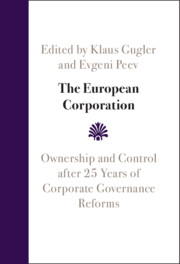Book contents
- The European Corporation
- The European Corporation
- Copyright page
- Contents
- Figures
- Tables
- Contributors
- Preface
- Acknowledgements
- 1 Introduction
- Part I Anglo-Saxon Countries
- Part II Central European Countries
- Part III Scandinavian Countries
- Part IV Mediterranean Countries
- Part V European Transition Countries
- 8 Bulgaria
- 9 Slovenia
- References
- Index
9 - Slovenia
from Part V - European Transition Countries
Published online by Cambridge University Press: 01 June 2023
- The European Corporation
- The European Corporation
- Copyright page
- Contents
- Figures
- Tables
- Contributors
- Preface
- Acknowledgements
- 1 Introduction
- Part I Anglo-Saxon Countries
- Part II Central European Countries
- Part III Scandinavian Countries
- Part IV Mediterranean Countries
- Part V European Transition Countries
- 8 Bulgaria
- 9 Slovenia
- References
- Index
Summary
This chapter studies the ownership transformation of the Slovenian economy after 1991. Although the Slovenian ownership structure was not formally dominated by the state initially (due to so-called social ownership), it became so due to the distribution formula applied in the course of privatization. Until 2008, Slovenia was perceived as the new EU member state with the largest state holdings and the lowest share of foreign ownership. However, due to numerous management buyouts and ownership consolidations within and across industries before 2009, the landscape of Slovenian corporate ownership changed dramatically in the decade following the financial crisis. The main reason was that companies involved in management buyouts, mergers and acquisitions became insolvent after refinancing conditions tightened with the onset of the financial crisis. This led to radical changes in ownership through a series of foreign takeovers of troubled companies, the privatization of fifteen state-owned enterprises and all the banks receiving the state aid in the course of bank restructuring. This explains the radical increase in ownership concentration in the 100 largest Slovenian companies over the three decades and the rise of holding companies and foreign strategic investors as the main owners of the largest Slovenian companies in the late 2010s.
- Type
- Chapter
- Information
- The European CorporationOwnership and Control after 25 Years of Corporate Governance Reforms, pp. 237 - 263Publisher: Cambridge University PressPrint publication year: 2023

